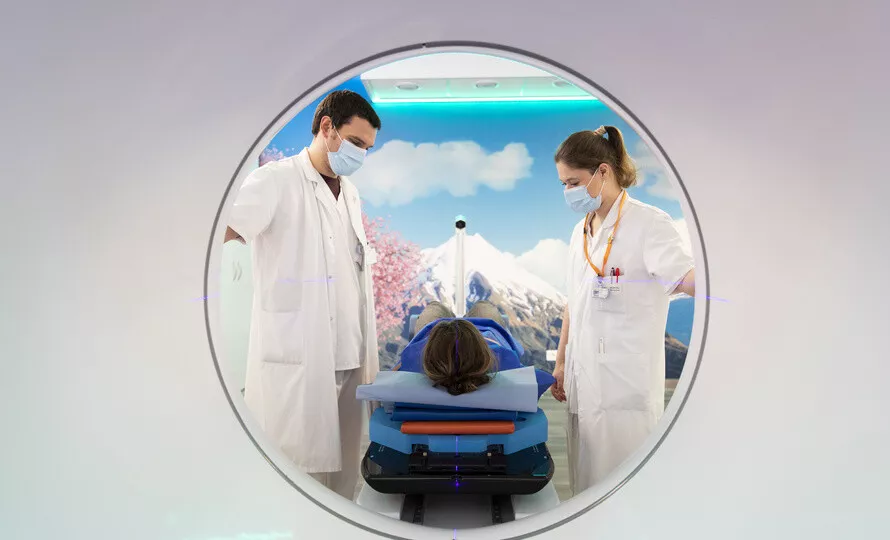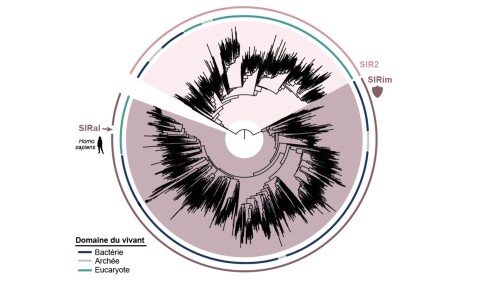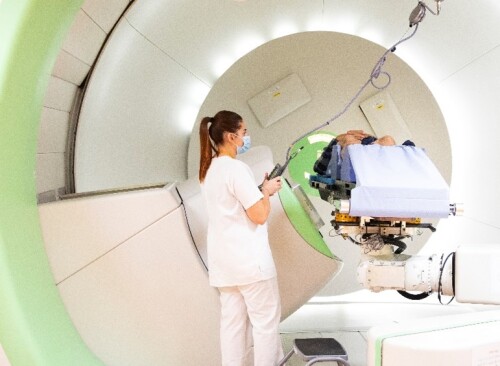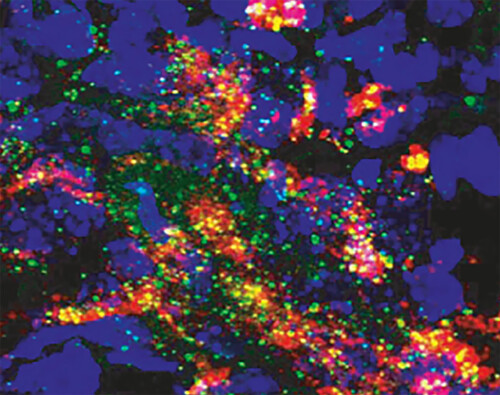
Over 70% of cancer treatments include radiotherapy sessions, proving that this treatment is a crucial tool in the tumor-fighting arsenal. The historic birthplace of radiotherapy, Institut Curie now has Europe’s most comprehensive technical radiotherapy platform, and is France’s leading proton therapy center. For World Cancer Day, on February 4, 2023, Institut Curie presents the groundbreaking technologies (Mini-beam, FLASH, etc.) that are emerging from its research laboratories and announces a major investment plan to offer more pioneering technologies in the field of radiotherapy. With the sole aim of better treatment for cancer patients, including children, with increasingly precise, conservative and tailored treatments that guarantee better quality of life for patients.
Over 190,000 patients have their cancer treated with radiotherapy in France each year[1]. Used alone or in combination with surgery or chemotherapy, these sessions involve local delivery of rays (electrons, photons, protons) that destroy the cancer cells by causing damage to their DNA. However, radiotherapy can also cause damage to certain neighboring healthy tissues and lead to after-effects. Radiotherapy presents a twofold challenge: to increase tumor-fighting effectiveness and to reduce side effects. There are some promising leads in these fields at Institut Curie.
Prof. Thierry Philip, Chairman of the Executive Board at Institut Curie, declares: “The historic birthplace of radiotherapy, Institut Curie is now looking to state-of-the-art innovation in terms of innovative research, development of its technical platform, and its technological performance. Researchers and physicians at the institute are joining forces to offer new radiotherapy methods and better treatment combinations to as many patients as possible, including children.”
56 million euros over 6 years for radiotherapy at Institut Curie
With Europe’s most comprehensive technical radiotherapy platform, Institut Curie is France’s leading proton therapy center. In 2023, Institut Curie is launching a broad-ranging radiotherapy program involving a major investment plan to boost the modernization of its technical platform and offer its patients the most innovative and groundbreaking techniques. This major plan involves 56 million euros invested over 6 years, covering all radiotherapy equipment and all Institut Curie sites: Paris, Saint-Cloud and Orsay.
The ultra-sophisticated techniques that will increasingly help optimize patient care include stereotactic radiotherapy (high-precision, high-dose irradiation), respiratory-gated radiotherapy (which adapts to movements due to breathing, thus protecting healthy tissues) and adaptive radiotherapy (adaptation of the treatment plan according to variations observed during irradiation).
Prof. Steven Le Gouill, director of the Hospital Group at Institut Curie, explains: “Our radiotherapy investment plan is an ambitious project that will strengthen Institut Curie’s innovation in medical physics as well as in engineering sciences and imaging. Our future ultra-sophisticated radiotherapy equipment will enable us to optimize treatments and care for our patients, who will enjoy increasingly precise, complementary and conservative techniques for as many locations as possible.”
Key figures and info:
> More than 190,000 patients treated by radiotherapy each year in France > 106,963 radiotherapy sessions in 2021 at Institut Curie > 11 particle accelerators at Institut Curie (6 in Paris, 4 in Saint-Cloud, and 1 in Orsay aside from proton therapy) > An investment plan of 56 million euros invested over 6 years covers all radiotherapy equipment and all Institut Curie sites: Paris, Saint-Cloud and Orsay. > The third most important proton therapy center in the world, in terms of the number of patients treated since it opened in 1991. > Only 10 centers worldwide practice proton therapy in ophthalmology and Institut Curie is the leading center worldwide in terms of total number of patients, with 360 patients treated on average each year. > In pediatrics: 100 patients treated each year, one quarter of whom are treated under general anesthesia. A majority are children under the age of 5. |
A new era for radiotherapy: adaptive and tailored
The stakes of radiotherapy care have shifted dramatically in recent years, due to medical and technological progress, and this sea change will continue in the coming years. Patients are now treated and monitored over the long term. Some treatments such as repeat irradiation are increasingly common, and this changes patient care.
Adaptive radiotherapy will be a routine clinical tool, enabling radiotherapists to adapt to development of the tumor as irradiation is happening, but also to the patient’s anatomy or position, to better protect the healthy tissues. And these techniques will be made possible by integrating artificial intelligence software or embedded imaging systems. “Our project will drive Institut Curie to offer optimum treatment for patients of course, but also for health professionals,” declares Prof. Gilles Créhange, head of Institut Curie’s oncology-radiotherapy department. “Today, thanks to the latest generation equipment, we have the means to interpret all the data, to predict how the disease evolves and to anticipate increasingly complex treatments to serve our patients.”
One of the innovative approaches already used in a clinical setting at Institut Curie is hypofractionated radiotherapy, offered since 2021. It involves reducing the number of sessions to offer greater comfort to patients, particularly elderly breast cancer patients without high risk of recurrence. Another typical example of care at Institut Curie is a stereotaxis technique (“concentrated” radiotherapy) for some patients with localized prostate cancer. It involves just 5 sessions spread out over 1 1/2 weeks (compared with conventional treatment lasting 2 months) and reduces side effects. In more advanced cancer cases, Institut Curie specialists offer a new approach, known as “boost”, which combines external radiotherapy with brachytherapy[2].
A look at proton therapy: an ultra-precise form of radiotherapy and unrivalled “Curie” expertise in treating children
Proton therapy is proton beam radiotherapy, whose huge benefit lies in the ballistic properties that allow very precise targeting. With protons, the dose can be delivered to the tumor in a single very narrow beam, which enlarges, and stops in the tumor, making proton therapy the treatment of choice when the tumor is located near to sensitive organs. The Proton Therapy Center at Institut Curie based in Orsay is France’s leading center and the top center in the world for treating ophthalmological tumors. Several types of diseases are treated there for intra- and extra-cranial locations, particularly in children. The ability of proton therapy to focus precisely reduces the total dose of irradiation to which the body is exposed, which explains why it is useful in pediatrics. Since 2017, Institut Curie’s proton therapy center at Orsay is the only one that has mastered an innovative approach for cranial and brain tumors that require treatment of the brain and the spinal cord, completing sparing the organs in the chest and abdomen. In children and young adults, physicians also offer proton therapy for mediastinal Hodgkin’s lymphoma, a form of blood cancer. This proton therapy technique requires the use of respiratory control via spirometry to prevent mobility of organs linked to the respiratory system, since this combination reduces cardio-pulmonary toxicity. Institut Curie’s Orsay site is the only proton therapy center in France since 2018 to offer this treatment technique. Institut Curie takes part in national and international clinical proton therapy clinical trials for childhood and adult tumors at the base of the skull, soon to be extended to the esophagus and pancreas. |
Revolutionary research for breakthrough technologies
The international community has not seen this type of buzz in radiotherapy for decades, with totally innovative technologies, which in the coming years could change the landscape for patients. Although much progress has been made in terms of imaging precision, ballistics and dosimetry, new dose delivery methods, with new biological effects on tissues, are paving the way for promising therapeutic solutions to target tumors that until now have been radio-resistant, and to considerably reduce long-term after-effects. Institut Curie’s teams are pioneers in the emergence of revolutionary radiotherapy solutions.
“Institut Curie’s DNA is that of an osmosis between interdisciplinary research and clinical practice. Original and promising therapies are emerging from this rivalry”, declares Prof. Alain Puisieux, Director of the Institut Curie Research Center. “Recent research breakthroughs at Institut Curie in physics and radiobiology, but also in terms of image analysis combined with artificial intelligence, pose new challenges which are creating a buzz in the international community.”
- Mini-beams: a true paradigm shift
A new dose delivery system has been discovered by the “New Approaches in Radiotherapy” team headed by Dr. Yolanda Prezado, a physicist and CNRS research director. Indeed, her team - SIRIC accredited (Integrated cancer research site) - is a pioneer in research on proton mini-beam radiotherapy (pMBRT): a strategy that uses submillimetric proton beams and is proving very promising for treating radioresistant tumors with a poor prognosis, particularly in pediatrics. “Our goal is to exploit the fact that by changing the physical parameters of radiation, in other words the way in which we deliver the dose, we can change the biological effects and thus improve treatments,” explains Dr. Yolanda Prezado. This new cancer therapy approach is based on strong spatial modulation of the dose with alternating high and low doses, contrary to the uniform dose distributions used in standard radiotherapy. Recent preclinical work by her team shows that this pMBRT technique activates separate radiobiological mechanisms and reduces side effects which limit the effectiveness of irradiation in treatment of brain tumors. This new technique provides hope for tumors with a poor prognosis, in particular gliomas and certain pediatric cancers. The results showed significant reduction of after-effects (in terms of cognitive ability, memory, anxiety), encouraging for the preparation of clinical trials. The research also revealed good activation of the immune system, which paves the way for effective combinations with immunotherapy, including cell therapy.
- FLASH radiotherapy causes a furor
Discovered in 2014 in Institut Curie laboratories at Orsay by the team of Vincent Favaudon, a radiobiology researcher at Inserm, “FLASH” is a radiotherapy technique where ultra-high dose rate irradiation (10 Gray or more, equal to the dose received in one week of conventional radiotherapy) is delivered in a fraction of a second, i.e. 1,000 to 10,000 times more intense than conventional radiotherapy. This technique destroys the tumor cells while sparing the healthy tissue and if the next research steps lead to approval for future clinical application, FLASH radiotherapy will provide new opportunities for cancer treatment. Studies are conducted on FLASH radiotherapy at Institut Curie, on different types of electron and proton particle accelerators. Recent preclinical research conducted by the team of Dr. Yolanda Prezado in proton FLASH have revealed reduced toxicity compared with conventional proton therapy, in tumors of the central nervous system in young patients. Furthermore, there is considerable hope in the field of FLASH radiotherapy using very high energy electrons (VHEE). In the coming years, combining the FLASH effect with a very high energy electron source could revolutionize radiotherapy, by targeting deep tumors and avoiding complex surgery.
- “Bait” molecules which increase the effectiveness of radiotherapy
At Institut Curie, the “Repair, Radiation and Innovative Anti-cancer Therapies” team, thanks to the work of Dr. Marie Dutreix, emeritus research director at the CNRS, has developed a unique new class of drugs, namely Dbait molecules, which increase the effectiveness of radiotherapy. When seeking to understand the resistance to radiation observed in almost 20% of patients, along with her team she developed these small molecules which resemble damaged DNA, tricking the cells into thinking that the quantity of damage to repair after radiotherapy or chemotherapy treatment is much higher than is actually the case. The tumor cell, “overwhelmed” by the quantity of damage to be repaired, self-destructs. A clinical trial is currently underway with the biotech Onxeo with this innovative therapy, which represents major hope for the fight against high-risk pediatric cancer in particular.
Other teams at Institut Curie are involved in research particularly in imaging, IT, and mathematics. Since the future of anti-cancer therapies lies in combining treatments, a number of projects are underway at Institut Curie that combine radiotherapy-immunotherapy, radiotherapy and nanoparticles, FLASH and Dbaits, in order to build a battery of tools against cancer.
|
Radiotherapy at Institut Curie: innovation is in our DNA Over one hundred years ago, Maris Curie, a trained physicist, was convinced that ionizing radiation could be a crucial tool in the fight against cancer. Since then, radiotherapy has seen continual improvements through technological progress.
From discovery of radium to the birth of radiotherapy: > X-rays discovered in 1895 by Wilhelm Conrad Röntgen (in Germany), and radium discovered in 1898 by Pierre and Marie Curie, paved the way for new cancer treatments, including roentgen therapy, radium therapy and brachytherapy, the forefathers of radiotherapy. > 1901: a dermatologist from the modern-day Saint-Louis hospital in Paris, Henri Danlos, learns about the work of Pierre Curie and publishes his results on treating lupus with radium. Other physicians carry out tests on other pathologies. > 1903: Marie and Pierre Curie receive the Nobel Prize in Physics for their work on radioactivity. > 1905: the beneficial action of radium rays for treating tumors of the skin and the cervix is recognized: this is the birth of brachytherapy. > 1911: Marie Curie also receives the Nobel Prize in Chemistry for the discovery of radium and polonium, for isolation of radium and the study of this element. > 1924: two American physicians, Blumgart and Weiss, use a tracer (radium C) for the first time in humans, to measure the speed at which blood circulates from one arm to the other. > 1934: Irène and Frédéric Joliot-Curie discover artificial radioactivity, offering the possibility to create radioactive isotopes of all the natural elements. This discovery led to the emergence of nuclear medicine. Isotopes find a variety of uses, from medical research to diagnostic and therapeutic applications. |
[1] Source Inca: https://www.e-cancer.fr/Professionnels-de-sante/Les-traitements/Radiotherapie/Chiffres-cles-de-la-radiotherapie
[2] Brachytherapy involves putting radioactive sources in contact with or inside tumors, for more targeted treatment. It can be prescribed for certain prostate, gynecological, anal canal and eye cancers.



